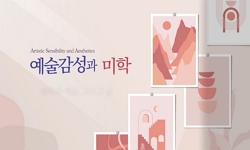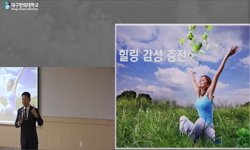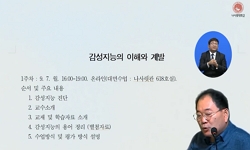The present paper takes note of the toxicity of images today, and aims to propose countermeasures to overcome contamination of images through an analysis of nimitta as it appears in the Pāli-Nikāya. From early on, the Buddha noted the problems raise...
http://chineseinput.net/에서 pinyin(병음)방식으로 중국어를 변환할 수 있습니다.
변환된 중국어를 복사하여 사용하시면 됩니다.
- 中文 을 입력하시려면 zhongwen을 입력하시고 space를누르시면됩니다.
- 北京 을 입력하시려면 beijing을 입력하시고 space를 누르시면 됩니다.
https://www.riss.kr/link?id=A104502103
-
저자
이창규 (서울불교대학원대학)
- 발행기관
- 학술지명
- 권호사항
-
발행연도
2017
-
작성언어
Korean
-
주제어
니밋따(Nimitta) ; 초기경전(Pāli-Nikāya) ; 심상(mental image) ; 감성 ; 원인 ; 삼매 ; 부정관 ; Nimitta ; Pāli-Nikāya ; Mental image ; Sensibility ; Reason ; Samādhi ; Contemplation of the impure (asubha bhāvanā)
-
등재정보
KCI우수등재
-
자료형태
학술저널
-
수록면
195-223(29쪽)
-
KCI 피인용횟수
0
- DOI식별코드
- 제공처
- 소장기관
-
0
상세조회 -
0
다운로드
부가정보
다국어 초록 (Multilingual Abstract)
Such discussions regarding nimittas suggest that there is a need for a systematic study on the significance and role of nimittas as mentioned by the Buddha. However, the research on nimittas in Korea is scarce, and most of the existing studies deal only with the practice of concentration meditation. Thus this paper seeks to arrive at a correct understanding of nimittas through an analysis of their context in the Pāli-Nikāya. To this end, we looked at the uses of the term “nimitta” in the five Nikāyas of the Pāli-Nikāya, and examined the key meanings and functions of nimitta in three aspects: nimitta as exterior image, nimitta as cause, and nimitta as mental image. Moreover, we sought to systematize the various meanings and roles of nimitta by considering its role as a hindrance (nīvaraṇā)—associated with the arising and proliferation of nimittas—together with its role in mental development.
The present paper takes note of the toxicity of images today, and aims to propose countermeasures to overcome contamination of images through an analysis of nimitta as it appears in the Pāli-Nikāya. From early on, the Buddha noted the problems raised by the contamination of nimittas, and emphasized correct understanding of the true nature of nimittas and mental development (bhāvanā) to remove the contaminated nimittas. Recently mental development in regard to nimittas is used as an instrument to develop concentration meditation (jhāna) rather than to arrive at a fundamental understanding of the true nature of nimittas. There is also the worry that focusing solely on achieving concentration meditation without correct knowledge could have the adverse effect of obstructing meditation.
Such discussions regarding nimittas suggest that there is a need for a systematic study on the significance and role of nimittas as mentioned by the Buddha. However, the research on nimittas in Korea is scarce, and most of the existing studies deal only with the practice of concentration meditation. Thus this paper seeks to arrive at a correct understanding of nimittas through an analysis of their context in the Pāli-Nikāya. To this end, we looked at the uses of the term “nimitta” in the five Nikāyas of the Pāli-Nikāya, and examined the key meanings and functions of nimitta in three aspects: nimitta as exterior image, nimitta as cause, and nimitta as mental image. Moreover, we sought to systematize the various meanings and roles of nimitta by considering its role as a hindrance (nīvaraṇā)—associated with the arising and proliferation of nimittas—together with its role in mental development.
국문 초록 (Abstract)
이에 본 논문에서는 초기경전에 나타나는 문맥의 분석을 통하여 니밋따의 바른 이해를 도모하고자 하였다. 이를 위해 초기경전의 5부 니까야(Nikāya)에 나타난 니밋따의 용례를 찾아보고, 니밋따의 주요 의미와 기능을 형상적 니밋따, 원인의 니밋따, 심상적 니밋따의 세가지 측면에서 살펴보았다. 나아가 니밋따의 발생과 그 증식 과정에 따른 장애로서의 니밋따와 수행으로서의 니밋따를 함께 고찰해 봄으로써 니밋따의 다양한 의미와 역할을 체계화하고자 하였다.
본 논문은 오늘날 이미지의 유독성에 주목하여, 이미지의 오염을 극복하기 위한 대응책을, 초기경전(Pāli-Nikāya)에 나타난 니밋따(Nimitta)의 분석을 통해 제시하고자 하였다. 붓다에 의하면 일...
본 논문은 오늘날 이미지의 유독성에 주목하여, 이미지의 오염을 극복하기 위한 대응책을, 초기경전(Pāli-Nikāya)에 나타난 니밋따(Nimitta)의 분석을 통해 제시하고자 하였다. 붓다에 의하면 일체의 존재는 삼사화합의 접촉을 통해 마음에 나타난 니밋따일 따름이다. 니밋따는 우리 자신과 무관하게 존재하는 외부의 객관적 대상이 아니라, 감각적 경험에 의거하여 지각된 이미지에 해당하는 것으로, 발생의 순간부터 욕망에 노출되어 있다. 붓다는 일찍이 니밋따의 오염으로 인한 문제점을 지적하여, 니밋따의 실상에 관한 올바른 이해와 오염된 니밋따를 제거하기 위한 수행을 강조하였다. 그러나 근래의 니밋따 수행에 대한 관심은 니밋따의 실상을 이해하기 위한 근원적인 접근보다는 선정을 계발하기 위한 하나의 도구로 활용되고 있다. 니밋따에 관한 올바른 지혜 없이 선정 성취에만 치중한다면, 자칫 명상을 방해하는 역기능을 초래할 우려가 있는 것도 또한 사실이다. 니밋따에 대한 이러한 논의는 붓다가 언급한 니밋따의 의미와 역할이 무엇인지에 대해 체계적인 연구가 필요함을 시사하고 있다. 그러나 국내의 니밋따와 관련한 연구는 미미한 편으로 대부분 명상 수행적 측면에서만 다루어지고 있다.
이에 본 논문에서는 초기경전에 나타나는 문맥의 분석을 통하여 니밋따의 바른 이해를 도모하고자 하였다. 이를 위해 초기경전의 5부 니까야(Nikāya)에 나타난 니밋따의 용례를 찾아보고, 니밋따의 주요 의미와 기능을 형상적 니밋따, 원인의 니밋따, 심상적 니밋따의 세가지 측면에서 살펴보았다. 나아가 니밋따의 발생과 그 증식 과정에 따른 장애로서의 니밋따와 수행으로서의 니밋따를 함께 고찰해 봄으로써 니밋따의 다양한 의미와 역할을 체계화하고자 하였다.
참고문헌 (Reference)
1 슈미트하우젠, "「성문지」에서의 선정수행과 해탈경험" 금강대학교 불교문화연구소 1 (1): 125-159, 2006
2 비구 보디, "팔정도" 고요한 소리 2011
3 각묵스님, "초기불교입문" 이솔출판 2014
4 전재성, "초기불교의 연기사상" 한국빠알리성전협회 2002
5 임석진, "철학사전" 중원문화 2008
6 行場次朗, "지성과 감성의 심리학" 웅보출판사 2002
7 하코다 유지, "인지심리학" 교육을 바꾸는 책 2014
8 대림스님, "앙굿따라니까야 1" 초기불전연구원 2010
9 대림스님, "아비담마 길라잡이 (상)(하)" 초기불전연구원 2009
10 전재성, "쌍윳따니까야 4,5,6,7" 한국빠알리성전협회 2007
1 슈미트하우젠, "「성문지」에서의 선정수행과 해탈경험" 금강대학교 불교문화연구소 1 (1): 125-159, 2006
2 비구 보디, "팔정도" 고요한 소리 2011
3 각묵스님, "초기불교입문" 이솔출판 2014
4 전재성, "초기불교의 연기사상" 한국빠알리성전협회 2002
5 임석진, "철학사전" 중원문화 2008
6 行場次朗, "지성과 감성의 심리학" 웅보출판사 2002
7 하코다 유지, "인지심리학" 교육을 바꾸는 책 2014
8 대림스님, "앙굿따라니까야 1" 초기불전연구원 2010
9 대림스님, "아비담마 길라잡이 (상)(하)" 초기불전연구원 2009
10 전재성, "쌍윳따니까야 4,5,6,7" 한국빠알리성전협회 2007
11 지산스님, "붓다의 길 위빠사나의 길" 도서출판 한길 2005
12 월폴라 라훌라, "붓다의 가르침과 팔정도" 한국빠알리성전협회 2009
13 조애너 메이시, "불교와 일반시스템이론" 불교시대사 2004
14 일중스님, "미얀마 파욱 사야도가 지도하시는 호흡관(Ānāpānassati) 수행법" 불교문화원 62-75, 2006
15 전재성, "맛지마니까야" 한국빠알리성전협회 2009
16 임승택, "마음과 철학 불교편" 서울대학교출판문화원 1-28, 2013
17 각묵스님, "디가니까야 3" 초기불전연구원 2006
18 전재성, "디가니까야" 한국빠알리성전협회 2011
19 미산스님, "대념처경의 수행이론과 실제" 홍원사 49-84, 2005
20 정준영, "나, 버릴 것인가 찾을 것인가" 운주사 41-96, 2008
21 김재성, "五停心觀의 초기불교에서의 위치" 불교학연구회 31 (31): 183-224, 2006
22 Schmithausen Lambert, "Ālayavijñāna: on the origin and the early development of a central concept of Yogācara philosophy 2vols" The International Institute for Buddist Studies 1987
23 YAMAZAKI M, OUSAKA Y, "compiled. Index to the Dīgha-Nikāya" The Pali Text Society 1997
24 Robert E. Buswell Jr., "The Princeton Dictionary of Buddhism" Princeton University Press 2013
25 Bodhi Bhikkhu, "The Numerical Discourses of the Buddha: A Translation of the Aṅguttara Nikāya" Wisdom Publication 2012
26 Johansson, Rune. E. A., "The Dynamic Psychology of Early Buddhism" Curzon Press 1979
27 "Sutta Nipāta, PTS"
28 "Saṁyutta Nikāya, PTS"
29 Rhys Davids, T.W., "Pali–English dictionary" PTS 1986
30 "Majjhima Nikāya, PTS"
31 Hamilton, Sue, "Identity and Experience: The Constitution of the Human Being According to Early Buddhism" Luzac Oriental 1996
32 Schmithausen Lambert, "Epiphanie des Heils, Zur heilsgegenwart in indischer und christlicher Religion" 59-85, 1982
33 Anālayo Bhikkhu, "Encyclopaedia of Buddhism, Vol.Ⅶ" Published by the Government of Sri Lanka 177-179, 2003
34 "Dīghā Nikāya, PTS"
35 Kalupahana David J., "Buddhist Philosophy: A Historical Analysis" The University Press of Hawaii 1976
36 "Aṅguttara Nikāya, PTS"
37 Monier-Williams, M., "A Sanskrit-English Dictionary" Oxford University Press 1989
동일학술지(권/호) 다른 논문
-
- 불교학연구회
- 김한상
- 2017
- KCI우수등재
-
산스크리트 복합어(samāsa)의 어순에 관한 고찰 -upasarjana, pūrvanipāta 개념을 중심으로
- 불교학연구회
- 김현덕
- 2017
- KCI우수등재
-
- 불교학연구회
- 岡本一平
- 2017
- KCI우수등재
-
- 불교학연구회
- 한상희
- 2017
- KCI우수등재
분석정보
인용정보 인용지수 설명보기
학술지 이력
| 연월일 | 이력구분 | 이력상세 | 등재구분 |
|---|---|---|---|
| 2020 | 평가예정 | 계속평가 신청대상 (등재유지) | |
| 2019-06-17 | 학회명변경 | 영문명 : Korea Association of Buddhist Studies -> Korean Association of Buddhist Studies | |
| 2019-06-11 | 학회명변경 | 영문명 : The Korean Society For Buddhist Studies -> Korea Association of Buddhist Studies | |
| 2019-06-07 | 학술지명변경 | 외국어명 : BUL GYO HAK YEONGU-Journal of Buddhist Studies -> Korea Journal of Buddhist Studies | |
| 2015-01-01 | 평가 | 우수등재학술지 선정 (계속평가) | |
| 2011-01-01 | 평가 | 등재학술지 유지 (등재유지) |  |
| 2009-01-01 | 평가 | 등재학술지 유지 (등재유지) |  |
| 2006-01-01 | 평가 | 등재학술지 선정 (등재후보2차) |  |
| 2005-01-01 | 평가 | 등재후보 1차 PASS (등재후보1차) |  |
| 2003-01-01 | 평가 | 등재후보학술지 선정 (신규평가) |  |
학술지 인용정보
| 기준연도 | WOS-KCI 통합IF(2년) | KCIF(2년) | KCIF(3년) |
|---|---|---|---|
| 2016 | 0.48 | 0.48 | 0.51 |
| KCIF(4년) | KCIF(5년) | 중심성지수(3년) | 즉시성지수 |
| 0.52 | 0.47 | 0.937 | 0.11 |





 KCI
KCI 스콜라
스콜라







